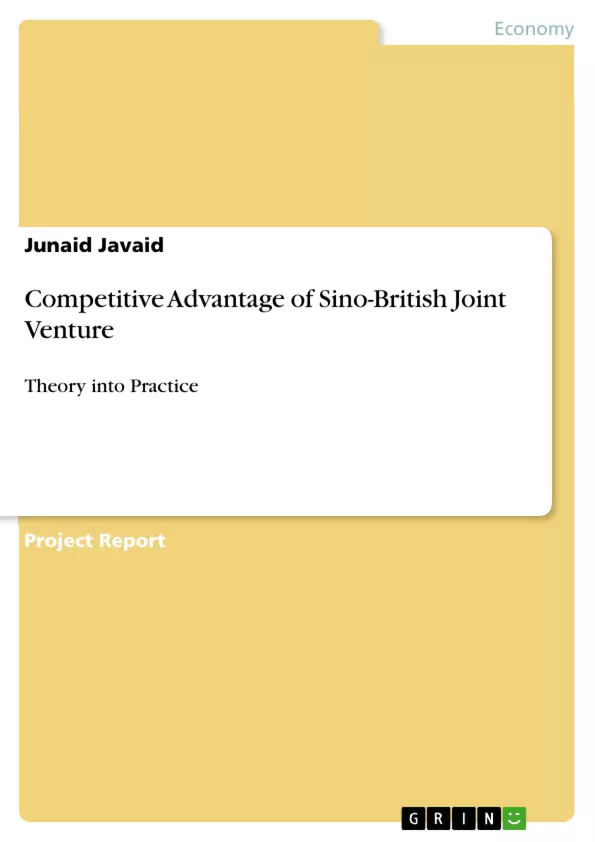This report is written on the topic named “Competitive Advantage of Sino-British Joint Ventures in China”. This study has examined five Sino-British Joint Ventures (one company each from the Chemical, Telecommunication & Environmental Consulting Sectors). In general the large number of Multinational Enterprises (MNEs) and domestic companies operating in China are increasingly becoming competitive. In this regard, Joint Ventures based on Sino-British orientation are facing tough competition in the Chinese territory. Majority of studies conducted on the International Joint Ventures (IJV) are seems to focus more on partnership and with its related issues (Ownership & Control, Cultural Differences, Cross-Cultural Management, Strategic Goals & Formation, Technology Transfer & Performance). It has been determined that competitive issues are appeared to be neglected. This report is aims to discuss the Joint Ventures’ competitive success & failure from the perspective of Resource-Based View (RBV) and Strategic Positioning by taking into consideration the significant factors (Partnership & Locational Specific Factors).
Different Case Studies are examined on the basis of following concerns: (i) Distinguished Traits of each Joint Venture (ii) Configuration of Activities involved in the Value Chain process with Positioning Strategy (iii) Partnership in accordance with configuration of Resources and Capabilities with the Operational activities (iv) Significance of Locational specific factors and (v) Sources of Sustainable competitive advantage. Moreover, the report also discusses the implications of this study on the concept of Joint Ventures on the general basis. The implications are based on certain aspects (appropriate boundary for the brief understanding of International Strategic Alliance, Development of critical & valuable resources within the context of Organisational & Local context and the exploitation of vertical linkages across the value chain processes.
Inhaltsverzeichnis (Table of Contents)
- CHAPTER-1: AIMS & OBJECTIVES
- 1.1. BACKGROUND CONTEXT
- 1.2. RESEARCH QUESTION
- 1.3. RESEARCH OBJECTIVES
- CHAPTER-2: LITERATURE REVIEW
- 2.1. INTERNATIONAL PRODUCTION
- 2.2. HOST COUNTRY CONDITIONS
- 2.3. INTER-FIRM COOPERATION & JOINT VENTURES
- 2.4. COMPETITIVE ADVANTAGE & STRATEGY
- CHAPTER-3: CASE STUDIES ON SINO-BRITISH JOINT VENTURES
- 3.1. THE POSITIONING PERSPECTIVE
- 3.1.1. INDUSTRY
- 3.1.2. POSITIONING & COMPETITIVE ADVANTAGE
- 3.1.3. PARTNERSHIP
- 3.1.4. LOCATIONAL FACTORS
- 3.2. RESOURCE BASED VIEW
- 3.1. THE POSITIONING PERSPECTIVE
- CHAPTER-4: DISCUSSION & CONCLUSION
- 4.1. DISCUSSION
- 4.2. CONCLUSION
- 4.3. LIMITATION OF RESEARCH
- 4.4. RECOMMENDATIONS FOR FUTURE STUDIES
- CHAPTER-5: REFRENCES
Zielsetzung und Themenschwerpunkte (Objectives and Key Themes)
This report investigates the competitive advantage of Sino-British joint ventures in China. It examines five specific joint ventures across different industries and aims to understand the factors contributing to their success or failure. The study focuses on the interplay of resource-based view and strategic positioning perspectives to analyze the ventures' competitive strengths and weaknesses. This report explores how these ventures achieve competitive advantage within the dynamic and competitive Chinese market.
- Competitive Advantage of Sino-British Joint Ventures
- Strategic Positioning and Resource-Based View Perspectives
- Partnership and Locational Factors
- Host Country Conditions and International Production
- Sustainable Competitive Advantage in Joint Ventures
Zusammenfassung der Kapitel (Chapter Summaries)
Chapter 1: Aims & Objectives introduces the research question and objectives, highlighting the competitive landscape of Sino-British joint ventures in China. It establishes the context for the study by discussing the factors influencing the competitive intensity of the Chinese market.
Chapter 2: Literature Review provides a comprehensive overview of relevant literature on international production, host country conditions, inter-firm cooperation, joint ventures, and competitive advantage. This chapter lays the theoretical foundation for the subsequent analysis.
Chapter 3: Case Studies on Sino-British Joint Ventures presents detailed analyses of five case studies, examining their positioning strategy, resource-based view perspectives, partnership dynamics, and locational factors. It aims to identify key factors contributing to their competitive success or failure.
Chapter 4: Discussion & Conclusion discusses the implications of the findings from the case studies, drawing broader conclusions about the competitive advantage of Sino-British joint ventures. It also highlights limitations of the study and proposes recommendations for future research.
Schlüsselwörter (Keywords)
This report focuses on the competitive advantage of Sino-British joint ventures in China. The primary keywords and focus topics include: international joint ventures, competitive advantage, competitive strategy, positioning perspective, resource-based view, locational factors, activities configuration, and sustainable competitive advantage. The research utilizes these concepts to examine the dynamics of Sino-British joint ventures within the Chinese market.
- Quote paper
- Junaid Javaid (Author), 2013, Competitive Advantage of Sino-British Joint Venture, Munich, GRIN Verlag, https://www.grin.com/document/262561



